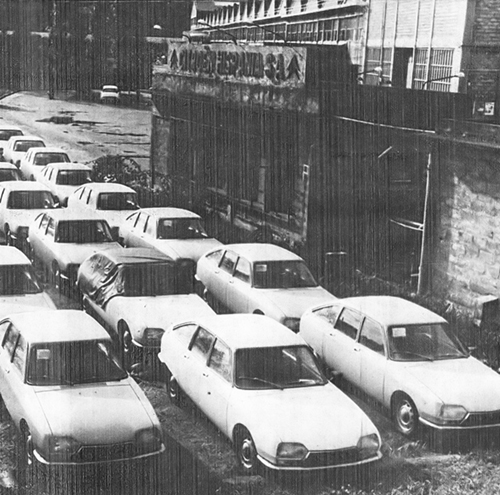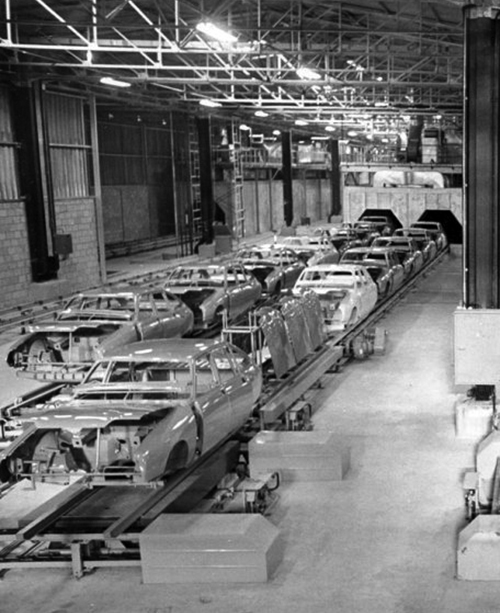|
THE ENIGMA OF "THE FIRST VIGO
GSs”
1971 saw the first CitroŽn GS made in Spain but the official figures
show 1978 as the first year of production. So why the discrepancy?
To answer this question we must go back to April 1958 when CitroŽn,
responding to the high tariff barriers that protected Spain's domestic
auto-makers, established the Vigo car plant in Galicia. As in
many countries, imported cars were taxed at a higher rate than
domestically produced vehicles and this led many manufacturers to build
cars in strategically important markets. Local regulations
usually required that a certain percentage (by value) of a car must use
domestically produced parts and components. Vigo was the chosen
location because it was both a port and a free port. Transactions
that occur within a free port are generally not subject to local taxes
which facilitates the export of products.
The Vigo factory had been used to assemble local derivatives of the A
series vehicles until 1971 and production was focused on the domestic
market.
Felipe Cucciardi researched the production data and discovered that the
GS began to be manufactured in Spain in 1971, a year after its launch
in France, but the GS did not go on sale in Spain until 1973 when the
1220 engined version was produced. The fiscal regime of those years
required domestic production of parts which the factory was unable to
finance, in particular the hydropneumatic components which had to be
imported from France. Had Spanish built cars with French hydraulic
components been built, they would have been subject to the same import
taxes as complete cars imported from France. Thus, the Spanish factory
could only import items from France if the end product was exported.
80% of the car was French while the Spanish components made up the
remaining 20%. For this reason, were exported to the Netherlands
via monthly shipments where they were not listed as French cars, but as
Spanish, albeit with French car prices. The cars were shipped on a
freighter that took Volkswagens from Germany to the United States
which,
were it not for these ‘El Vigo’ GSs would have returned empty.
Instead, the vessel called in to Vigo where the Spanish GSs were loaded
and shipped to the Netherlands.
In 1972 the company invested 700 million pesetas as a result of which
they achieved a Spanish-built percentage of 70% which eventually
increased to 90%. This meant it was treated as a domestically produced
car and could be sold in Spain at a reasonable price.
But in 1971, the 1,015 engines, the front and rear suspension
assemblies and steering were imported from France, while gearboxes were
made in Spain. The body assembly, the entire painting process and the
final assembly were all performed in Vigo.
Production started in Vigo in either September or October 1971 at an
artisanal level of five cars a day with a total production that year of
270.
French data states that production of the GS in Spain began in 1978.
However, it seems that this is the date on which the Vigo GS became
totally Spanish (without any imported parts). These first GSs were
manufactured in Spain but with French components which explains why the
production is counted in France.
In 1972, as a result of the change in fiscal legislation CitroŽn
instituted an expansion plan that included:
• The establishment of a
production plant in the industrial area of San Ciprian de ViŮas
(Orense) for mechanical parts.
• Restructuring, modernisation and
expansion of facilities in the Vigo Freeport.
• The creation of a distribution
centre in Porrino (Vigo).
• Production of 58,000 units per
year.
A new international strategy was adopted by the parent company, which
then
began to market some of the models produced in Vigo in various
international markets.
Spanish GSs evolved along the same lines as the French cars but the
Pallas was renamed 'Palas'.
From 1978, Spanish cars were sold throughout Europe.
|
|
Year
|
GS
|
GSA
|
|
1971
|
270
|
|
|
1972
|
1,044
|
|
|
1973
|
6,144
|
|
|
1974
|
19,796
|
|
|
1975
|
32,920
|
|
|
1976
|
48,725
|
|
|
1977
|
55,542
|
|
|
1978
|
58,137
|
|
|
1979
|
35,239
|
16,190
|
|
1980
|
|
32,288
|
|
1981
|
|
9,657
|
|
1982
|
|
15,355
|
|
1983
|
|
61,132
|
|
1984
|
|
18,510
|
|
1985
|
|
7,130
|
|
1986
|
|
49
|
|
Total
|
257,817
|
160,311
|
|
French data indicate that production of the CitroŽn GS
began in Spain
in 1978. It would seem that this is when the GS became totally Spanish
(i.e. without any imported parts).
|
|
 |
Above some of the 270 vehicles
destined for export to the Netherlands in 1971
|
|











































